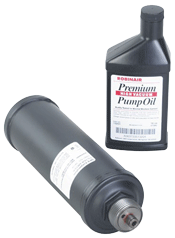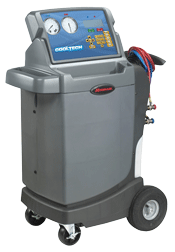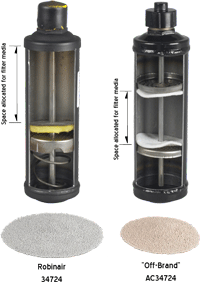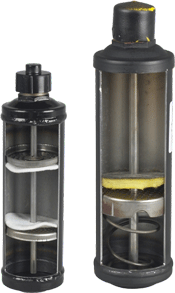|
|
|
| Why It's Critical |
|
For today’s service shop owner or manager there’s hardly time to worry about the condition of your maintenance equipment, let alone the consequences of not purchasing OEM service parts for the maintenance or repair of the equipment. Despite the enormous pressure regarding price, there is in fact a long term cost savings to make the choice for genuine manufacturer’s maintenance parts.
Cost savings are like compounding interest |
in a savings account and come in ways of reliability, performance, efficiency, quality and performance that OEM replacement parts bring. Since a manufacturer’s service parts are designed specifically for a make and model of equipment, they bring dependability and continuity to these critical functions in a vehicle service facility. The choice for generic or after market service parts opens the door to malfunctions that can jeopardize these important concerns. |
In the following sections we’re going to take a closer look at the why it’s import to change the filter, and some of the differences between OEM and “off brand” service parts used on A/C recover, recycle and recharge (A/C RRR) machines and show how the performance, reliability, efficiency and quality can be affected when non– OEM service parts are used for repair service or scheduled maintenance. |

|
| |
Why is it important to change the filter?
|
 |
Most people under-stand the importance of replacing the filter on an A/C RRR ma-chine. In case you don’t, this filter is the one that needs to be replaced before, or up to150 lbs. of refrigerant has been recovered by the AC RRR machine, or the user is locked-out from using their machine.
This is not the only reason changing the filter is important. The filter also serves as a critical trap that helps capture and remove moisture, particles and any other impurities |
that may be mixed with the refrigerant as part of the recovery and recycling process. This helps ensure that the refrigerant being put back into the vehicle being serviced meets refrigerant recycling purity specification our machines are design to meet.
The 150lb recovered refrigerant filter counter is calibrated to the type of filter we use. Using a filter of lesser quality, or one that doesn’t exactly match these specifications could affect the purity level of the refrigerant |
you are putting back into a customer’s vehicle and may make the refrigerant being put back into the vehicle out of compliance with the refrigerant recycling purity specifications. This could lead to system failures, improper system performance, and the dreaded customer return claiming you didn’t fix their A/C problem.
|
| Recently, an “off-brand” replacement filter meant for a Robinair A/C RRR machine was purchased for a local distributor. When the filter arrived some differences were noted. First, the “off-brand” filter was quite a bit lighter. When placed on a scale the ‘off-brand” filter weighed 3.0 lbs. versus 4.6lbs for the Robinair OEM filter. When the “off-brand” filter was shaken, you could hear something moving within the enclosed filter. |
|
The Inside Story |
 |
We had both filters both filters cut open to analyze and compare what was in-side. What we found was a surprising difference in both design and the amount of desiccant used in each filter.
After removal all of the desiccant from each filter, the different desiccants were weighed. The “off brand” filter included only 0.64 lbs. of desiccant by weight, whereas the Robiniair filter |
included 1.5 lbs. of desiccant by weight almost 2 1/2 times more desiccant than what was found in the “off-brand” filter. Desiccant is what removes any moisture that may be found in the refrigerant as it’s recovered from a vehicle’s A/C system. Robinair A/C machines are calibrated to work in conjunction with the Robinair filter. If the “off-brand” filter is used in the A/C machine the desiccant in the filter may become saturated |
with refrigerant and require replacement long before the 150 lbs. change filter notification that is provided by the Robinair A/C machine.
The “off-brand” filter’s lack of adequate desiccant may adversely affect the performance of any Robinair A/C RRR machine and may lead to replacement of refrigerant with moisture back into a customer’s vehicle. |
|

|
Filter design can make the difference.
|
|
In addition to the difference in the amount of desiccant used in each filter, there is a difference in the design of the “off-brand” filter.
The “off-brand” brand filter includes two plates that are held in place on both ends with retaining clips. In between these plates is where the desiccant is located. One of the initial observations was, when the filter was shaken you could hear something moving around. This sounded turned out to be the desiccant moving back and forth between the plates.
In comparison, the Robinair filter includes a spring below a lower plate. This spring helps keep the desiccant tightly packed together. |
This helps ensure that as refrigerant flows through the filter a “path-way” can’t be established through the desiccant. In the “off-brand” filter with nothing holding the desiccant tightly together, there is the possibility a path of least resistance pathway could be established, which would allow the refrigerant to flow through this filter without coming in con-tact with much of the desiccant.
This may limit the filter’s ability to remove any moisture or contaminants from the refrigerant as it is being recovered. |
From the outside both filters look similar, but after taking a closer look inside it is apparent why use of an official Robinair OEM filter to service your Robinair A/C RRR machine is recommended
The next time you need a replacement filter, ask for genuine Robinair service parts. |

|
|
|
|




